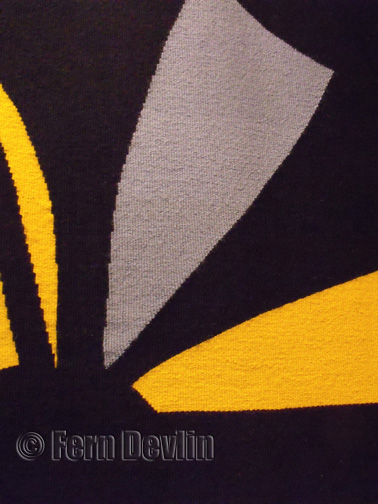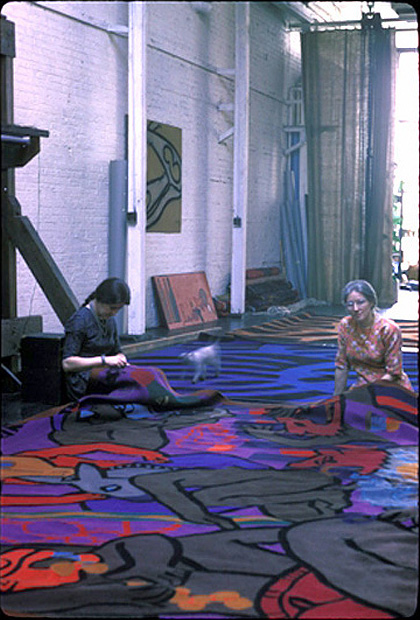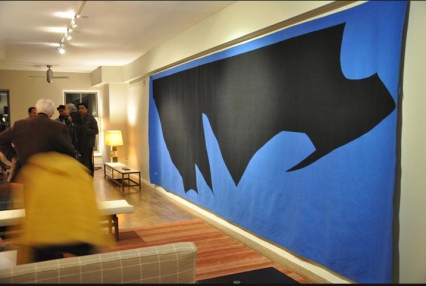
"Annabert Weaving" (c) the Yoors Family Partnership
With some exceptions, I am not a fan of contemporary tapestry weaving, so when my friend Ann Rosenthal called recently to ask if I had seen Annabert Yoors’s obituary in the paper, I asked, “Who?” Ann said, “She was a weaver who wove with her husband, and there’s a picture of her at her loom. Maybe it will be your next article.” I didn’t know who Annabert Yoors was, and when I finally found the obituary, I still didn’t recognize the small, grainy picture in the paper as being of a weaver at her loom, even when I was looking right at it The photo at the top of this post is a clearer, enlarged version of the one that was in the New York Times’ June 29 obituary.
So if I didn’t know who Ann was talking about, why did the name Yoors ring a bell deep in my memory? I associated it vaguely with my friend, mentor, and one-time boss at Atwood Fabrics, Sharon, so I e-mailed to ask whether she remembered mentioning someone named Yoors to me. Sharon surprised me by replying, “As far as Yoors is concerned, you’re right . . . I modeled for him when I first met Gerry. His studio was above hers.” Ann’s call and Sharon’s remark started me on a meandering trip back to bohemian New York.
I started my research by reading about Jan Yoors (1922-77), and learned that he was a protean figure, Belgian-born, whose life story is worthy of a screenplay. In fact two films were made about him, but I was only able to track down one, a short video called Weaving Two Worlds, available on Amazon. The other film is mentioned in Cathryn Drake’s excellent article about the Yoorses, “Tied in the Wool,” in the June 2001 issue of Metropolis magazine online.
If you’re interested in reading about Yoors — and as I said, his life is such a great yarn one would swear it was fiction — I also recommend the article “Bohemian Rhapsody,” by Beatrice V. Thornton, in the current issue of Modern magazine. Modern magazine was unfamiliar to me, but it’s an interesting, stylish new quarterly interior design magazine that focuses on midcentury furniture and conoisseurship. Ms. Thornton writes, “In his relatively short life he [Jan Yoors] became a sculptor, a painter, a filmmaker, a writer, an illustrator, and a photographer, as well as a member of the World War II underground . . . But if any medium can be said to secure the name of Jan Yoors in the pantheon of artist-artisans, it is his work in tapestry.”
Jan, Annabert (his first wife), and Marianne (his second wife) came to NYC after World War II. Jan had been trained as a sculptor, but after seeing a tapestry exhibition, he became smitten by French tapestries. So the three set up an independent tapestry studio in NYC in 1951, according to Kore Yoors, son of Marianne and Jan. It was “at 96 Fifth Avenue [in Greenwich Village]. It was the Van Buren estate, which was converted to artists’ studios — William Zorach, Jack Levine, and Kalas, to name a few.”
They built their large vertical tapestry loom themselves and taught themselves to weave so Annabert and Marianne could produce the large tapestries Jan designed. The warps were cotton, and the wefts were custom-dyed, richly colored Persian wool. It didn’t surprise me to learn that Jan’s father, Eugène, was a well-known stained-glass artist (see below), because there are echoes of stained-glass style in Jan’s bold shapes, solid blocks of saturated colors, and black accents. The image below is one of Eugène Yoors’s stained-glass works.

Stained glass by Eugene Yoors
and this is a detail from one of Jan’s tapestries, Tantric Yellow.

Detail "Tantric Yellow" tapestry by Jan Yoors
Historically, the artists who designed tapestries were not the same people as the expert weavers who wove, or “transcribed,” them. The weavers worked facing the back of the piece and saw the front only in a mirror. But the Yoorses — like many other artist-weavers (including Ann Rosenthal) — worked facing the front side of the tapestry, which allowed them a freedom and spontaneity that they could not get the other way. (Notice the pattern in the tapestry that Annabert is weaving at the top of this post.)
I have no idea whether Jan Yoors was familiar with the work of William Morris when he took up tapestry weaving and set up his studio, but the parallels are striking. William Morris, the complex Pre-Raphaelite genius, lived about 100 years before Yoors, and he said, “The noblest of the weaving arts is tapestry: in which there is nothing mechanical.” He built a tapestry loom in his bedroom, taught himself to weave, and wove his first panel — which took him 516 hours to complete — in 1879. (My source for that information is Linda Parry’s fine 1983 book, William Morris Textiles.)
In 1959, the Yoorses moved their studio uptown to E. 47th St., near the United Nations, and it was there that my friend Sharon — a teenager at the time — was, coincidentally, learning to handweave bedspreads and handbags in a studio on the floor below. Sharon met Jan and modeled for tapestry sketches for a while, an experience she described as “mostly sitting around drinking Turkish coffee and chitchatting, and two women tiptoeing around.” The photograph below of Marianne, an unidentified feline, and Annabert was taken in that 47th St. studio.

"Yoors Studio 47th St." (c) the Yoors Family Partnership
(Of course, not all weavers have this kinship with cats, but the slideshow below contains a photo of Marianne weaving with a cat on a cushion beside her, and one that I slipped in of my cat Puffy and me in a similar arrangement.)
This slideshow requires JavaScript.
The Yoors studio remained on E. 47th St. until 1967, when they moved back to Greenwich Village, this time to Waverly Place. Jan Yoors died in 1977 at the age of 55, but, remarkably, the two women continued to live together, to raise their three children, and to complete Jan’s not-yet-woven tapestries.
Family dynamics are not my subject, but there are interesting insights from some members of the Yoors family in Cathryn Drake’s article, and also in Robert Lipsyte’s interesting 1998 interviews with Marianne and Annabert in the New York Times.
The research that I did made me long to see the actual work. In photographs, the tapestries look like hard-edged paintings, but in an uncannily serendipitous moment, I discovered a current exhibition of some Yoors tapestries at reGeneration Furniture in Soho, NYC.
ReGeneration Furniture is a seventeen-year-old store, owned by Valerie Guariglia and Christine Miele, that deals in midcentury vintage furniture, with a focus on the fifties. Yoors’s tapestries and other works harmonize beautifully with their furniture. The exhibition, scattered gracefully throughout the showroom, consists of three tapestries, a group of charcoal drawings, several photographs, and a variety of other material, all well chosen by Eric Hibit.

reGENERATION
The show opened in April and was scheduled to close July 17, but it has been attracting so much interest that Valerie and Christine decided to extend it through October.
The tapestries are flawlessly woven, and Jan’s bold designs look completely contemporary, even though the latest one in the show is dated 1975. The surfaces aren’t flat; they have a subtle ribbed texture that creates a quiet rhythm and warmth. And they look so at home on the first floor of reGeneration’s inviting two-story space that it feels as if they are, well, in somebody’s home. I hope that you will visit and enjoy the exhibition as much as I did.
Throughout the time I have spent on this story, I have been trying to figure out why I feel so close to it, and the answer is simple: it made me remember lands I have wandered through. I never was a “bohemian in Greenwich Village,” but I had relatives who were, and I “grew up” there in those years. Greenwich Village of that period will always be the sophisticated center of my New York, no matter how much it changes. It’s my spiritual home.
I am grateful to Kore Yoors for providing the picures of Jan, Marianne, Annabert, and the figurative tapestry Conquerors Will Be Conquered. The pictures from the exhibition at reGeneration are my own. I want to give sincere thanks to Kore Yoors and Valerie Guariglia for their generosity and help with this article. It’s been a pleasure.







